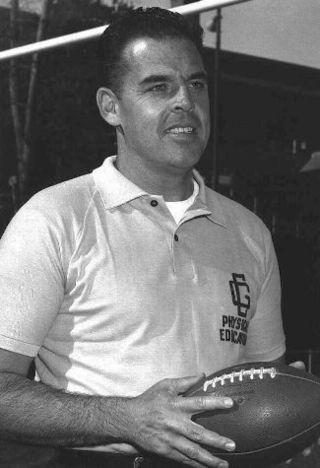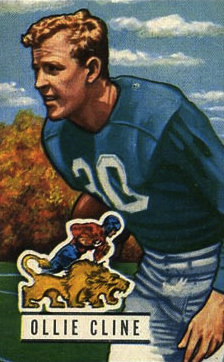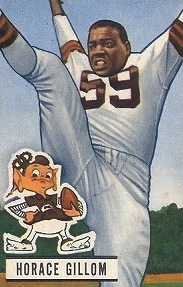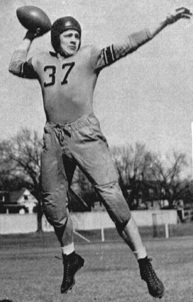
Otto Everett Graham Jr. was an American professional football quarterback who played for the Cleveland Browns in the All-America Football Conference (AAFC) and National Football League (NFL) for 10 seasons. Graham is regarded by critics as one of the most dominant players of his era and one of the greatest quarterbacks of all time, having taken the Browns to league championship games every year between 1946 and 1955, making ten championship appearances, and winning seven of them. With Graham at quarterback, the Browns posted a record of 105 wins, 17 losses, and 4 ties, including a 9–3 win–loss record in the AAFC and NFL playoffs. He holds the NFL record for career average yards gained per pass attempt, with 8.63. He also holds the record for the highest career winning percentage for an NFL starting quarterback, at 81.0%. Long-time New York Yankees owner George Steinbrenner, a friend of Graham's, once called him "as great of a quarterback as there ever was."

William Karnet "Bill" Willis was an American football middle guard and guard who played for eight seasons with the Cleveland Browns of the All-America Football Conference (AAFC) and the National Football League (NFL). Known for his quickness and strength despite his small stature, Willis was one of the dominant defensive football players of the 1940s and early 1950s. He was named an All-Pro in every season of his career and reached the NFL's Pro Bowl in three of the four seasons he played in the league. His techniques and style of play were emulated by other teams, and his versatility as a pass-rusher and coverage man influenced the development of the modern-day linebacker position. When he retired, Cleveland coach Paul Brown called him "one of the outstanding linemen in the history of professional football".

Louis Roy Groza, nicknamed "the Toe", was an American professional football offensive tackle and placekicker while playing his entire career for the Cleveland Browns in the All-America Football Conference (AAFC) and National Football League (NFL). Groza was professional football's career kicking and points leader when he retired after the 1967 season. He played in 21 seasons for the Browns, helping the team to win eight league championships in that span. Groza's accuracy and strength as a kicker influenced the development of place-kicking as a specialty; he could kick field goals from beyond 50 yards (46 m) at a time when attempts from that distance were a rarity. He set numerous records for distance and number of field goals kicked during his career.

Marion Motley was an American football fullback and linebacker who played for the Cleveland Browns in the All-America Football Conference (AAFC) and the National Football League (NFL). He was a leading pass-blocker and rusher in the late 1940s and early 1950s, and ended his career with an average of 5.7 yards per carry, a record for running backs that still stands. A versatile player who possessed both quickness and size, Motley was a force on both offense and defense. Fellow Hall of Fame fullback Joe Perry once called Motley "the greatest all-around football player there ever was".

Leslie Horvath was an American football quarterback who won the Heisman Trophy while playing for the Ohio State Buckeyes in 1944. Horvath was the first Ohio State player to win the Heisman, an award given to the best college football player in the United States. The school retired his jersey number 22 in October 2000.

Dante Bert Joseph Lavelli, nicknamed "Gluefingers", was an American professional football end who played for the Cleveland Browns in the All-America Football Conference (AAFC) and the National Football League (NFL) from 1946 to 1956. Starring alongside quarterback Otto Graham, fullback Marion Motley, kicker Lou Groza and fellow receiver Mac Speedie, Lavelli was an integral part of a Browns team that won seven championships during his 11-season career. Lavelli was known for his sure hands and improvisations on the field. He was also renowned for making catches in critical situations, earning the nickname "Mr. Clutch". Browns head coach Paul Brown once said of him: "Lavelli had one of the strongest pairs of hands I've ever seen, when he went up for a pass with a defender, you could almost always count on him coming back down with the ball."

Anthony Adamle was an American professional football player who was a linebacker and fullback in the All-America Football Conference (AAFC) and the National Football League (NFL). He played his entire career for the Cleveland Browns before retiring to pursue a medical degree.

Thomas Laverne James, Jr. was an American football defensive back and punter who played for Ohio State University and the Cleveland Browns in the 1940s and 1950s. He was born in Canton, Ohio and attended Massillon Washington High School, where he played as a back on the football team under head coach Paul Brown. James was a key part of a Massillon team that went undefeated in 1940. After graduating, he followed Brown to Ohio State and played there as a halfback. Ohio State won its first national championship in 1942 when James was on the team.

Oliver Monroe Cline was a college and professional American football fullback who played for the Ohio State Buckeyes, Cleveland Browns and Detroit Lions in the 1940s and 1950s. A standout high school athlete in his hometown of Fredericktown, Ohio, Cline attended Ohio State University starting in 1944. He became the football team's primary fullback that year as the school went unbeaten and was ranked second in the nation in the AP Poll. The following year, Cline was named the most valuable player in the Big Ten Conference, rushing for 936 yards as Ohio State built up a 7–2 record and was ranked 12th in the AP Poll. Following a brief stint in the U.S. Army at the end of World War II, Cline returned to Ohio State for a final season in 1947.

Warren Emmett Lahr was an American professional football player who was a defensive back who played for the Cleveland Browns for 11 seasons, mainly in the 1950s. When he retired, he had the most career interceptions in Browns team history with 44.

Horace Albert "Big Horse" Gillom was an American professional football player who was a punter and end in the All-America Football Conference (AAFC) and National Football League (NFL). He played ten seasons for the Cleveland Browns between 1947 and 1956. Cleveland head coach Paul Brown, who coached Gillom in high school, college and professionally, called him his best all-around high school player and once said there "has never been a better punter than Horace".

James Lachlan Daniell, nicknamed "Big Jim", was an American football offensive tackle and defensive tackle, a World War II veteran, and a steel company executive. He played two years in the National Football League (NFL) and All-America Football Conference (AAFC).

Robert James Steuber was an American football halfback who played one season in National Football League (NFL) and three seasons in the All-America Football Conference (AAFC). He played college football for the Missouri Tigers, where he quickly became one of the country's most productive runners and scoring threats. He was second in the country in 1942 with more than 1,000 yards of rushing. Steuber was drafted by the NFL's Chicago Bears and played one game for the team, appearing as a substitute on September 26, 1943, in the Green Bay Packers' home opener, which ended in a 21–21 tie. The next day, Steuber entered the United States Navy and was transferred to DePauw University for pre-flight training. Despite having gone from amateur status to professional football, Steuber was allowed to return to college football six days later and led the DePauw Tigers to a 50–0 win over Illinois Normal College, rushing for 225 yards and scoring 25 points in the first half. Playing for DePauw's football team in 1943, he led the nation in scoring.

Lindell Lee Houston was an American football guard who played eight seasons in the All-America Football Conference (AAFC) and in the National Football League (NFL) with the Cleveland Browns. He was the older brother of Jim Houston.

The 1942 Ohio State Buckeyes football team was an American football team that represented Ohio State University in the Big Ten Conference during the 1942 season. In their second season under head coach Paul Brown, the Buckeyes compiled a 9–1 record, outscored opponents by a total of 337 to 114, won the Big Ten championship, and was ranked No. 1 in the final AP poll, thus earning Ohio State their first ever national championship in program history.

George "Chief" Cheroke was a professional American football guard who played one season for the Cleveland Browns in the All-America Football Conference (AAFC). Cheroke grew up in Ohio and attended Ohio State University, where he was a standout player on the school's football team as a sophomore in 1941 under head coach Paul Brown. He left Ohio State after the season to join the military during World War II. When he was discharged in 1946, he joined the Browns, a new team in the AAFC coached by Brown. The Browns won the 1946 AAFC championship, but Cheroke was traded away at the end of the season. He cut his football career short to re-enlist in the Army, where he stayed for 20 years. He retired in 1965 and settled in California, working for Beckman Instrument Company in Los Angeles. Nephew George Cheroke born 8/25/43(named after uncle George) is a life long Cleveland Browns fan living in Post Falls, ID. with wife Kay.

Donald Adams Greenwood was an American football player and coach. He played professionally as a back for three seasons with the Cleveland Rams and the Cleveland Browns in the National Football League (NFL) and All-America Football Conference (AAFC).

Robert George Cowan was an American football halfback who played three seasons in the All-America Football Conference (AAFC) between 1947 and 1949. Cowan played for the Cleveland Browns and the Baltimore Colts.

Dean Sparks Sensanbaugher was a professional American football halfback and defensive back who played two seasons for the Cleveland Browns and New York Bulldogs in the All-America Football Conference (AAFC) and National Football League (NFL) in the late 1940s.
Edward J. "Foozy" Sustersic was an American football fullback and linebacker who played one season in the All-America Football Conference (AAFC) for the Cleveland Browns.




















